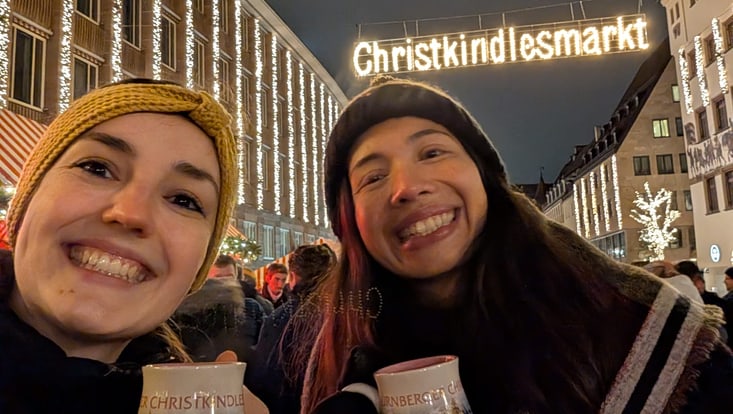MING Funded Conference Participation: Stella and Alejandra
30 July 2025

Photo: UHH/Gómez Correa/Buchwald
The MIN Graduate Center supports doctoral researchers by travel grants for conferences and research stays. The experiences on these trips are diverse and very interesting. Here is a report by Monica Alejandra Gómez Correa and Stella Zora Buchwald who attended the 68th 'Annual Meeting of the Palaeontological Association' in Erlangen, Germany:
In December 2024, we had the opportunity to attend the 68th Annual Meeting of the Palaeontological Association (picture 1), which, for the first time, was held outside the United Kingdom. The host institution in 2024 was the Friedrich-Alexander-Universität (FAU) Erlangen-Nürnberg in Germany. Between the 9th and 13th of December, the city of Erlangen was full of palaeontologists looking forward to sharing their newest findings in the field, discussing different topics, and gathering around the theme of “Extinction”. As our PhD projects are focusing on the environmental conditions and the response of different organisms to the most severe mass extinction event in Earth’s history, the Permian/Triassic mass extinction, the focus on extinction research was very intriguing to us, and one of the motivations to participate in the conference. In the opening ceremony, we had the opportunity to listen to excellent scientists at different career stages, who shared their expertise, state-of-the-art findings, open questions, and perspectives on how palaeontology can contribute to the understanding of climate change and the consequences of environmental changes.
At the conference, Stella presented the latest findings on biomarkers across the Permian/Triassic mass extinction in Svalbard on the second day under the title: “Molecular fossils from the Barents Shelf across the Permian/Triassic boundary in Svalbard” (picture 2), and Alejandra talked about the ostracod community across the Permian/Triassic mass extinction in Italy in a presentation titled “Adaptive response of shallow-marine ostracods during the Permian–Triassic climate crisis” (picture 3). In both presentations, we reached out to an audience with different expertise in various fields of palaeontology, who showed interest in our approach by asking questions and giving us feedback. We not only presented but also attended several talks during the conference days, some related to our current research topic while others were outside our specific field but very interesting (dinosaurs, Ediacaran fauna, phylogenetics, etc.).
Because of the diverse topics of the talks and because there were always three sessions running in parallel, we had informed ourselves about the conference programme before the start of the conference, and also checked every evening again which talks we wanted to attend the next day. During the coffee breaks, we met some of our collaborators, spoke with colleagues, and connected with researchers whose papers we had read (picture 4). The time for the poster session was also an opportunity to gather around the posters, meet the scientists conducting the research, and ask firsthand about their methods and results. The conference programme kept us engaged throughout the days of the conference. Still, because of the Christmas season, we also enjoyed visiting the famous Nürnberg Christmas market (picture 5) and Erlangen's small but cozy Christmas markets.
In summary, attending the 68th Annual Meeting of the Palaeontological Association was a great experience because we had the opportunity to present our work, learn from other perspectives, and forge valuable connections that will enhance our future research efforts. We thank the faculty for supporting our attendance at this conference and look forward to continuing to connect with the people we met there.
